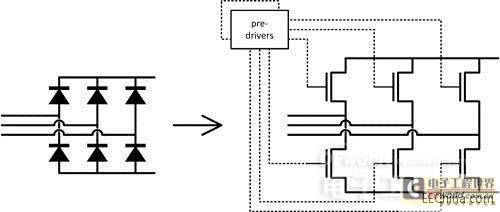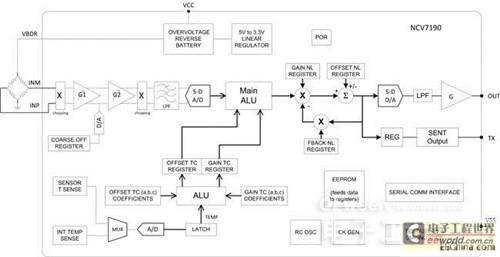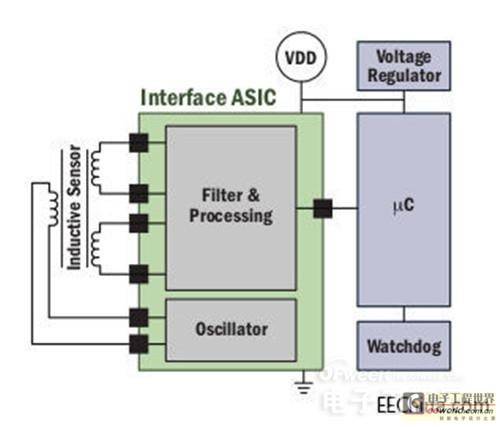Today's vehicles are being developed to provide high energy efficiency while minimizing environmental impact. But in the long term, non-petroleum-based powertrains appear to be the most promising solution; in the meantime, the automotive industry is introducing more improvements based on existing technologies. One major trend is hybridization, with a lot of growth opportunities for micro-hybrids (including stop-start systems) and mild hybrids. These "mild hybrid" solutions may seem outdated, but the industry is still conducting a lot of electronic and mechanical development around these applications.
This article will first look at some great examples of continued improvement related to the Lundell electric motor, better known as the "alternator." Thanks to better electronic control, its energy efficiency has increased, more energy is recovered, and the effects of frequent engine starts are smoothed. The second part of the article will focus on the additional sensors added to the car, which will help further reduce the traditional internal combustion engine's dependence on oil. The last section explains how existing inductive sensor technology can optimize the brake pedal to help the car save more energy.
1. Start the alternator
In the starter alternator system, the passive rectifier diodes are replaced by high current switches that drive the starter alternator as a motor (starter mode) and perform synchronous rectification on the stator current generated inside the alternator (alternator mode).
Synchronous rectification significantly improves alternator efficiency by shunting the (body) diode with a highly conductive path, reducing the forward voltage drop to less than 150 mV.

Figure 1: Synchronous rectification in an AC generator
One of the main functional challenges of this application is to ensure that the switch turns off very quickly when the stator current reverses; any delay in the switch turning off will cause unnecessary battery discharge in a manner very similar to the reverse recovery of a conventional diode. For this reason, pre-driver ICs contain high-skewness drivers operating inside an autonomous gate control loop, designed to achieve the best possible compromise between ohmic losses during rectification and transition losses when the current changes sign. Integrating these pre-drivers in an IC is quite complex.
First, it requires that multiple different voltage domains coexist on the same silicon substrate while ensuring reliable communication between these voltage domains.
Secondly, the driver IC that starts the alternator is placed in the harshest possible environment and may be subject to multiple transient events such as battery reversal, load dump, cathode ground transfer, very large dV/dt on the stator phases (on the order of 100 V per microsecond), electromagnetic interference, etc. Again, using differential technology and careful management of parasitic (bipolar) effects on the silicon substrate, it is possible to build such ICs using cost-effective buck technology rather than silicon-on-insulator (SOI) technology.

Figure 2: A robust pre-driver is used to control a high gate-source capacitance (Cgs) MOSFET in a starter alternator.
In addition to traditional lead-acid batteries, we see more and more energy storage components being used in the power network in start-stop systems, such as lithium-ion batteries, supercapacitors, etc. In these systems, the safety area becomes as important as the core functionality. Therefore, we see the ISO26262 safety standard coming into our field of vision more and more, sometimes resulting in a considerable part of the silicon area being dedicated to monitoring applications, detecting the health of this IC and its companion ICs, and ensuring a safe state if necessary.
Finally, the combination of smart circuits and high-power components in close proximity means that the junction temperature of the control circuitry rises significantly; it is not uncommon to consider operating junction temperatures above 175°C in applications. In addition, during the component qualification phase, temperatures as high as 200°C may be used to further accelerate the aging process in order to keep the service life test duration within a reasonable 2,000 hours. This challenge can be effectively addressed by using a silicon process with an extended temperature range and taking the design constraints into account during the design phase.
2. Sensing technologies used in internal combustion engines
Sensors are enabling modern internal combustion engines to achieve unprecedented levels of efficiency while minimizing emissions. For example, mass air flow (MAF) sensors measure the amount of air entering the engine's combustion chamber so that the right amount of fuel can be injected. At the other end of the engine, oxygen and nitrogen oxide (NOx) sensors directly measure the composition of the exhaust gas and feed the information back to the engine control unit (ECU).
The advent of pressure sensors is virtually ubiquitous, representing a trend that has accompanied the evolution of the internal combustion engine and the quest for enhanced control. Initially, it was the manifold absolute pressure (MAP) sensor, which was an alternative to using a MAF sensor. As fuel injection technology advanced, automotive direct injection (GDI) and diesel direct injection (DDI) pressure sensors were required to measure the pressure of the fuel injected through the common rail fuel line connected directly to each cylinder's combustion chamber. The latter sometimes requires a diesel particulate filter (DPF) to reduce smoke, and the DPF requires sensors to help maintain proper operating conditions. Even outside the engine, tire pressure monitoring systems (TPMS) ensure that tires are properly inflated, providing not only better safety but also greater fuel efficiency due to reduced tire rolling resistance.
Another frontier for pressure sensors is in the combustion chamber itself. To provide ultimate combustion control, one of the requirements is to know the pressure in all cylinders accurately at all times. Some types of clean diesel engines already operate with the help of in-cylinder pressure sensors. Those same sensors are also a key enabler for new engines being developed, one example being homogeneous charge compression ignition (HCCI), a technology that aims to combine the low emissions of gasoline engines with the energy efficiency of diesel engines.
All of these advances present new technical challenges that require increasingly complex integrated electronics to address them. For example, better control requires greater precision, and tolerances of 0.5% are common today. At the same time, operating temperature ranges continue to expand as the placement of pressure sensing functions moves closer to the center of the engine. This places additional constraints on the sensing element and the electronics needed to compensate for its non-ideal characteristics.
The block diagram of the new generation of pressure sensor ICs is shown in Figure 3. Low noise analog front ends begin to provide high accuracy performance, followed by high precision sigma-delta analog-to-digital converters (ADCs). Complex digital signal processing provides nonlinear temperature compensation for the offset and sensitivity of the sensing element. The common 5 V analog output is gradually replaced by standard digital outputs such as single-edge nibble transmission (SENT) and PSI5. This approach reduces the total quantization error by eliminating the output digital-to-analog conversion in the sensor and the analog-to-digital conversion on the ECU side.
Each sensor is calibrated during production and the compensation coefficients are stored in the internal EEPROM.

Figure 3: Block diagram of the next generation precision signal conditioning interface IC for pressure sensors
3. Inductive position sensor interface for brake pedal
A typical brake pedal has only a switch that helps determine when the brake lights should be activated. With the addition of brake energy recovery (regen) capabilities, a new brake pedal position sensor is required. Essentially, a standard friction brake system is upgraded with a control system that measures the precise displacement of the brake pedal. When the brake pedal is only slightly displaced, the friction brake system will not activate. In this "regen band," the regen system measures brake pedal displacement and determines how much of the moving car's kinetic energy needs to be transferred to temporary energy storage. This energy storage can take many forms; original equipment manufacturers (OEMs) may prefer pneumatic or hydraulic accumulators, 48 V batteries, supercapacitors, or even flywheels. Mild hybrids convert the stored energy back into propulsion power for a limited time during the next acceleration phase, while micro hybrids use only electrical regeneration to power the boardnet for a longer period of time.
To measure the exact position of the brake pedal during the “recovery band”, a similar technique as used for the accelerator pedal can be used. Figure 4 shows a block diagram of a contactless sensor solution for this type of application.

Figure 4: Inductive position sensor application block diagram
The custom inductive sensor interface developed by ON Semiconductor takes advantage of advanced front-end filters and combines intelligent processing functions. The on-chip driver stimulates the sensor with at least one excitation inductor. The coupled output inductor of the sensor produces a signal containing information about the relative position of the excitation inductor and the output inductor. The change in the relative position of the inductors depends largely on the selected sensor design, and it is usually the result of linear or rotary motion. This integrated circuit then converts the electrical input and output signals of the sensor into digital position information. The resolved position signal is then transmitted to the microcontroller through an interface, which depends on customer requirements or preferences. A proprietary mixed signal scheme can be selected to match the sensor interface output format, including ratiometric voltage, sine-cosine (Sin-Cos) voltage, pulse width modulation (PWM), SENT or PSI5.
Semiconductor suppliers in the sensor space, in addition to having the required skills, should also present the right attitude towards the ISO26262 standard. Many pedal applications in cars are directly related to safety and need to be addressed with the right ISO26262 understanding, methods and toolset approach. Inductive sensors can be used in redundant configurations that share the same results with certain functions and provide independent data outputs to achieve ASIL-D requirements at the module level. Emerging recycling applications combined with new suitable safety standards are driving the industry towards the development of new integrated circuits that interface with inductive sensors.
in conclusion
Electronic component developers and suppliers are moving toward future automotive powertrains to make a difference on the road. While micro-hybrid and mild-hybrid vehicles offer relatively modest fuel economy improvements, they are very cost-effective. It is precisely this strong path of step-by-step automotive improvements that will enable most vehicles to steadily evolve toward new technologies while also building the foundation for the next generation of powertrains.
Previous article:Ford's new car has pedestrian detection and can brake automatically
Next article:Automatic parking is awesome! Bosch's innovative automotive technology outlook
- Popular Resources
- Popular amplifiers
- Car key in the left hand, liveness detection radar in the right hand, UWB is imperative for cars!
- After a decade of rapid development, domestic CIS has entered the market
- Aegis Dagger Battery + Thor EM-i Super Hybrid, Geely New Energy has thrown out two "king bombs"
- A brief discussion on functional safety - fault, error, and failure
- In the smart car 2.0 cycle, these core industry chains are facing major opportunities!
- The United States and Japan are developing new batteries. CATL faces challenges? How should China's new energy battery industry respond?
- Murata launches high-precision 6-axis inertial sensor for automobiles
- Ford patents pre-charge alarm to help save costs and respond to emergencies
- New real-time microcontroller system from Texas Instruments enables smarter processing in automotive and industrial applications
- Innolux's intelligent steer-by-wire solution makes cars smarter and safer
- 8051 MCU - Parity Check
- How to efficiently balance the sensitivity of tactile sensing interfaces
- What should I do if the servo motor shakes? What causes the servo motor to shake quickly?
- 【Brushless Motor】Analysis of three-phase BLDC motor and sharing of two popular development boards
- Midea Industrial Technology's subsidiaries Clou Electronics and Hekang New Energy jointly appeared at the Munich Battery Energy Storage Exhibition and Solar Energy Exhibition
- Guoxin Sichen | Application of ferroelectric memory PB85RS2MC in power battery management, with a capacity of 2M
- Analysis of common faults of frequency converter
- In a head-on competition with Qualcomm, what kind of cockpit products has Intel come up with?
- Dalian Rongke's all-vanadium liquid flow battery energy storage equipment industrialization project has entered the sprint stage before production
- Allegro MicroSystems Introduces Advanced Magnetic and Inductive Position Sensing Solutions at Electronica 2024
- Car key in the left hand, liveness detection radar in the right hand, UWB is imperative for cars!
- After a decade of rapid development, domestic CIS has entered the market
- Aegis Dagger Battery + Thor EM-i Super Hybrid, Geely New Energy has thrown out two "king bombs"
- A brief discussion on functional safety - fault, error, and failure
- In the smart car 2.0 cycle, these core industry chains are facing major opportunities!
- The United States and Japan are developing new batteries. CATL faces challenges? How should China's new energy battery industry respond?
- Murata launches high-precision 6-axis inertial sensor for automobiles
- Ford patents pre-charge alarm to help save costs and respond to emergencies
- New real-time microcontroller system from Texas Instruments enables smarter processing in automotive and industrial applications
- Regarding the clamping problem, discuss
- How to drive FT232+stm32?
- CBG201209U201T Product Specifications
- Keil compiles ADuC7029 and reports an error
- Technical Article: Optimizing 48V Mild Hybrid Electric Vehicle Motor Drive Design
- DIY an STLink V2.1
- Playing with Zynq Serial 18——[ex01] Trying out the first project based on Zynq PL
- Hangshun chip-HK32F103 xCxDxE data sheet
- How to lay digital and analog floors?
- The entire process of R&D and production of a chip

 ACPL-C780-060E
ACPL-C780-060E











 京公网安备 11010802033920号
京公网安备 11010802033920号